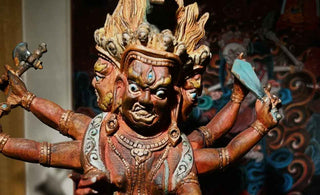
In the realm of Tibetan artistry, the craft of cloisonné unveils a world of intricate beauty and timeless elegance. Cloisonné, derived from the French word meaning "compartments," is an ancient technique that involves the meticulous arrangement of metal wires to create intricate patterns, which are then filled with vibrant enamel. This age-old craft has been an integral part of Tibetan statue decoration, adding a layer of exquisite detail and vibrant color to the divine forms.
At the heart of cloisonné lies a delicate dance between precision and artistry. Artisans, often referred to as master craftsmen, meticulously shape fine metal wires into intricate designs that delineate the contours of the statue. These wires create distinct compartments, or cloisons, that are then filled with colored enamel. The process requires not only a keen eye for design but also a deep understanding of the properties of enamel and metalwork.
The choice of enamel hues is not arbitrary; each color carries symbolic significance. Rich blues may represent the boundless sky, symbolizing the vast expanse of wisdom. Verdant greens may evoke the lush landscapes of enlightenment, and deep reds may signify the transformative power of compassion. As these vibrant colors merge within the cloisonné framework, they breathe life into the statue, turning it into a kaleidoscopic embodiment of spiritual meaning.
Consider a Tibetan statue adorned with cloisonné detailing, such as the serene depiction of Avalokitesvara, the bodhisattva of compassion. The fine wires contour the flowing robes and dynamic postures of the bodhisattva, creating a visual symphony that captures the essence of compassion in vivid detail. The cloisonné technique transforms the statue into a dynamic expression of divine energy, where every curve and color is a testament to the masterful craftsmanship and profound spiritual symbolism.
Beyond its aesthetic allure, cloisonné serves a functional purpose in preserving the statue. The enamel, once fired, forms a durable and protective layer that shields the metal from environmental factors.
Consider the exquisite Avalokiteshvara Bodhisattva (Guanyin Bodhisattva) Buddha Statue adorned with the intricate artistry of cloisonné. The artisan, with meticulous care, shapes fine metal wires into a sophisticated lattice that delineates the contours of the bodhisattva's flowing robes and dynamic posture. This cloisonné framework becomes the stage upon which a vibrant symphony of colors unfolds, each hue symbolizing profound spiritual meanings. Rich blues evoke the boundless sky of wisdom, verdant greens signify the lush landscapes of enlightenment, and deep reds embody the transformative power of compassion.
The functional significance of cloisonné becomes evident in the firing process, a transformative alchemy where the enamel, once applied, undergoes a metamorphosis into a durable and protective layer. This enamel shield serves as a formidable guardian, warding off the corrosive influence of environmental factors, including humidity and pollutants. As a result, the Avalokiteshvara Bodhisattva statue, bathed in the radiant hues of cloisonné, not only enchants the observer with its spiritual beauty but also stands resilient against the forces that threaten the integrity of its divine form.
The durable nature of cloisonné preservation ensures that the Avalokiteshvara statue becomes a timeless vessel of artistry, capable of withstanding the tests of climate and time. The enamel layer shields the underlying metal, preventing oxidation and corrosion that might compromise the intricate details crafted by the skilled artisan. This protective quality, inherent in the cloisonné process, becomes an unseen but integral part of the statue's longevity, allowing it to endure as a testament to Tibetan cultural heritage.
This preservation aspect ensures that the statue, whether depicting a compassionate bodhisattva or a fierce deity, stands the test of time, maintaining its resplendent beauty for generations to come.
In essence, the craft of cloisonné in Tibetan statue decoration is a celebration of both form and meaning. It is a testament to the rich tapestry of Tibetan culture, where art becomes a conduit for spiritual expression. Each stroke of the cloisonné brush, each fusion of color and wire, is a dialogue between the artisan and the divine—a harmonious symphony that resonates through the ages, encapsulating the timeless beauty of Tibetan artistry.
























